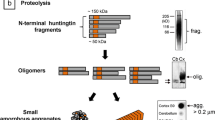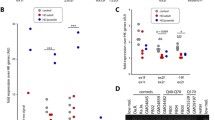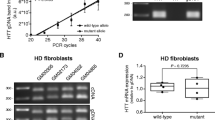Abstract
Background
An expanded CAG trinucleotide repeat is the genetic trigger of neuronal degeneration in Huntington’s disease (HD), but its mode of action has yet to be discovered. The sequence of the HD gene places the CAG repeat near the 5′ end in a region where it may be translated as a variable polyglutamine segment in the protein product, huntingtin.
Materials and Methods
Antisera directed at amino acid stretches predicted by the DNA sequence upstream and downstream of the CAG repeat were used in Western blot and immunohistochemical analyses to examine huntingtin expression from the normal and the HD allele in lymphoblastoid cells and postmortem brain tissue.
Results
CAG repeat segments of both normal and expanded HD alleles are indeed translated, as part of a discrete ∼350-kD protein that is found primarily in the cytosol. The difference in the length of the N-terminal polyglutamine segment is sufficient to distinguish normal and HD huntingtin in a Western blot assay.
Conclusions
The HD mutation does not eliminate expression of the HD gene but instead produces an altered protein with an expanded polyglutamine stretch near the N terminus. Thus, HD pathogenesis is probably triggered by an effect at the level of huntingtin protein.





Similar content being viewed by others
References
Martin JB, Gusella JF. (1986) Huntington’s disease: Pathogenesis and management. N. Engl. J. Med. 315: 1267–1276.
Folstein SE. (1989) Huntington’s Disease. A disorder of families. The Johns Hopkins University Press, Baltimore.
Vonsattel JP, Myers RH, Stevens TJ, Ferrante RJ, Bird ED, Richardson Jr EP. (1985) Neuropathological classification of Huntington’s disease. J. Neurol. Exp. Neuropath. 44: 559577.
Gusella JF, Wexler NS, Conneally PM, et al. (1983) A polymorphic DNA marker genetically linked to Huntington’s disease. Nature 306: 234–238.
Huntington’s Disease Collaborative Research Group. (1993) A novel gene containing a trinucleotide repeat that is expanded and unstable on Huntington’s disease chromosomes. Cell 72: 971–983.
Gusella JF, MacDonald ME, Ambrose CM, Duyao MP. (1993) Molecular genetics of Huntington’s disease. Arch. Neurol. 50: 1157–1163.
Gusella JF, MacDonald ME. Huntington’s disease. Semin. Cell Biol. 1, in press.
Ambrose CM, Duyao MP, Barnes G, et al. (1994) Structure and expression of the Huntington’s disease gene: Evidence against simple inactivation due to an expanded CAG repeat. Somat. Cell Mol. Genet. 20: 27–38.
Strong TV, Tagle DA, Valdes JM, et al. (1993) Widespread expression of the human and rat Huntington’s disease gene in brain and nonneuronal tissues. Nature Genet. 5: 259–265.
Li SH, Schilling G, Young III WS, et al. (1993) Huntington’s disease gene (IT15) is widely expressed in human and rat tissues. Neuron 11: 985–993.
Landwehrmeyer BG, McNeil SM, Ge P, et al. (in press) Huntington’s disease gene: Expression in brain of normal and affected individuals. Annals Neurol.
MacDonald ME, Ambrose CM, Duyao MP, Gusella JF. (1993) Capturing a CAGey killer. In: Genome Analysis. Vol. 7, Genome Rearrangement and Stability. Cold Spring Harbor Laboratory Press, New York, pp. 25–41.
Harlow E, Lane D. Antibodies, A Laboratory Manual. (1988) Cold Spring Harbor Laboratory Press, New York.
MacDonald ME, Lin C, Srinidhi L, et al. (1991) Complex patterns of linkage disequilibrium in the Huntington disease region. Am. J. Hum. Genet. 49: 723–734.
MacDonald ME, Novelletto A, Lin C, et al. (1992) The Huntington’s disease candidate region exhibits many different haplotypes. Nature Genet. 1: 99–103.
Anderson M, Gusella JF. (1984) Use of clyclosporin A in establishing Epstein-Barr virus-transformed human lymphoblastoid cell lines. In Vitro 20: 856–858.
Warner JP, Barron LH, Brock DJ. (1993) A new polymerase chain reaction (PCR) assay for the trinucleotide repeat that is unstable and expanded on Huntington’s disease chromosomes. Mol. Cell. Probes 7: 235–239.
Rubinsztein DC, Leggo J, Barton DE, Ferguson-Smith MA. (1993) Site of CCG polymorphism in the HD gene. Nature Genet. 5: 214–215.
Miner LL, Pandalai SP, Weisberg EP, Sell SL, Kovacs DM, Kaplan BB. (1992) Cold-induced alterations in the binding of adrenomedullary nuclear proteins to the promoter region of the tyrosine hydroxylase gene. J. Neurosci. Res. 33: 10–18.
Dignam JD. (1990) Preparation of extracts from higher eukaryotes. In: Deutscher MP (ed). Guide to Protein Purification. Vol. 182, Methods in Enzymology. Academic Press, New York, pp. 194–203.
Hockfield S, Carlson S, Evans C, Levitt P, Pintar J, Silberstein L. (1993) Selected methods for antibody and nucleic acid probes. In: Molecular Probes of the Nervous System. Cold Spring Harbor Laboratory Press, New York. Vol. 1, pp. 111–226.
Wexler NS, Young AB, Tanzi RE, et al. (1987) Homozygotes for Huntington’s disease. Nature 326: 194–197.
Myers RH, Leavitt J, Farrer LA, et al. (1989) Homozygote for Huntington’s disease. Am. J. Hum. Genet. 45: 615–618.
Hu QJ, Bautista C, Edwards GM, Defeo-Jones D, Jones RE, Harlow E. (1991) Antibodies specific for the human retinoblastoma protein identify a family of related polypeptides. Mol. Cell Biol. 11: 5792–5799.
Marquardt B, Stabel S. (1992) Sequence of a rat cDNA encoding the ERK1-MAP kinase. Gene 120: 297–299.
Mueckler MM, Pitot HC. (1985) Sequence of the precursor to rat ornithine aminotransferase deduced from a cDNA clone. J. Biol. Chem. 260: 12993–12997.
The I, Murthy AE, Hannigan GE, et al. (1993) Neurofibromatosis type 1 gene mutations in neuroblastoma. Nature Genet. 3: 62–66.
Golubic M, Roudebush M, Dobrowolski S, Wolfman A, Stacey DW. (1992) Catalytic properties, tissue and intracellular distribution of neurofibromin. Oncogene 7: 2151–2159.
Hoogeveen AT, Willemsen R, Meyer N, et al. (1993) Characterization and localization of the Huntington’s disease gene product. Hum. Mol. Genet. 2: 2069–2073.
Acknowledgments
We thank Drs. J. Settleman, S. Pillai, V. Ramesh, E. Harlow, A. Bernards, S. Reeves, and H. T. M. Timmers for supplying control antisera and for helpful discussion and the Brain Tissue Resource Center (McLean Hospital) for postmortem tissues and clinical information. This work was supported by National Institutes of Health Grants NS16367, NS22031, and NS32765, and by grants from Bristol-Myers Squibb, Inc., the Hereditary Disease Foundation, and the Huntington’s Disease Society of America. CA was supported by the Andrew B. Cogan Fellowship of the Hereditary Disease Foundation, and SM and MD were supported by fellowships from the Huntington’s Disease Society of America and the Hereditary Disease Foundation, respectively.
Author information
Authors and Affiliations
Rights and permissions
About this article
Cite this article
Persichetti, F., Ambrose, C.M., Ge, P. et al. Normal and Expanded Huntington’s Disease Gene Alleles Produce Distinguishable Proteins Due to Translation Across the CAG Repeat. Mol Med 1, 374–383 (1995). https://doi.org/10.1007/BF03401575
Published:
Issue Date:
DOI: https://doi.org/10.1007/BF03401575




